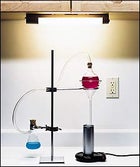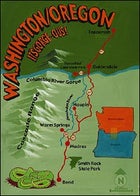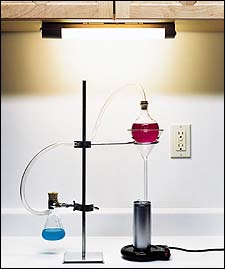OK, YOU’VE GOT your ratio of carbohydrates, protein, and fat dialed, and you graze through six small meals daily to keep your energy level up and your metabolism humming. Nice work. But guess what, sailor. There’s more to a high-performance diet than just the big picture, and it involves a bevy of nutritional bit players known as nutraceuticals. They lurk in many natural foods but also in those long lists of ingredients found on the wrappers and labels of nearly every power drink, energy bar, and gel you swallow (see “Big Boosts in Tasty Packages,” opposite). We’re talking about things like the magnesium, vitamin A, and soy protein listed at the bottom of the Nutrition Facts label.

Nutraceuticals are functional foods┬Śvitamins, minerals, compounds, and extracts┬Świth specific roles. They include herbs that increase your mental aptitude, phytochemicals that can fend off illness, antioxidants that help speed recovery, B vitamins that your body requires to metabolize food, and minerals to enhance your energy-delivery systems. Though nutraceuticals won’t shave an hour off your marathon time, there’s compelling evidence that the right balance of them in your diet can contribute to overall wellness and, consequently, help you train longer, recover faster, and avoid serious problems like heart disease and joint pain. “If you’re an athlete,” says Dr. Bernd Wollschlaeger, associate editor of the Journal of the American Nutraceutical Association, “you definitely want to pay attention to nutrition supplementation.”
Can this nutra-stuff really aid you on your upcoming Rainier climb or heated game of disc golf? Well, yes, assuming you know what it does and when and how to use it. Since manufacturers don’t face strict regulation by the FDA, they’re free to make any number of claims, leaving you to distill the real science from pharmacological science fiction. It’s not an easy task when facing a $20 billion industry with hundreds of products, so we’ve put together a guide to the primary nutritional mighty mites and organized them into five easily digestible categories: stimulants that jump-start your workout; hydration catalysts and endurance boosters that ramp up your performance; systems managers that keep your body in tune; and antioxidants that help you recover and stave off disease. Armed with this knowledge, you can train and perform better for years to come.
Stimulants
MAJOR PLAYERS: CAFFEINE AND GUARANA
THE CLAIM: Caffeine and guarana (a cocktail of caffeine and other stimulants that comes from Brazil’s guarana plant) stoke up a serious workout buzz, allowing you to exercise more intensely. They also sharpen your focus. “During a race, my mind goes a little fuzzy,” says Peter Reid, two-time Ironman Hawaii champion. “The caffeine in my gel restores my focus and makes my senses clearer.”
THE TRUTH: It’s no wonder Alberto Tomba gulped espresso right before his ski runs. A shot of caffeine will improve alertness and reaction time, and studies have shown that the caffeine equivalent of two to three cups of coffee raises your exhaustion threshold by five to eight minutes. Meanwhile, caffeine’s much maligned diuretic properties are not really an issue for athletes. “Caffeine is a diuretic only if you sit on your butt,” says Terry Graham, department chair of nutritional sciences at the University of Guelph, in Ontario, Canada. “Exercise within four hours of ingesting it and you nullify its dehydration effects.”
The problem is that many of the popular buzz drinks, like Red Bull, are sugar bombs. Consume more than 25 grams of sugar in such a small serving and you’re in trouble. “You can’t get any benefits from glucose until it reaches your bloodstream,” says Graham. “And high sugar levels prevent that from happening.”
Hydration Catalysts
MAJOR PLAYERS: SODIUM, POTASSIUM, AND FLAVOR
THE CLAIM: Ever since Gatorade turned University of Florida football into the comeback brigade in 1967, athletes have reaped the benefits of water with a little something extra. Now, pretty much every sports drink claims it will improve your performance by replacing essential electrolytes. The latest versions—enhanced waters like Propel—are marketed with claims that they hydrate with fewer calories.
THE TRUTH: It’s well-known that sweaty exercise flushes both water and sodium from your system, so to rehydrate, you require more than just H20. “You need to replace your lost minerals with something that contains minerals,” says Wollschlaeger. “They help your cells work efficiently to keep your body going.” Sodium and potassium also help you retain water, slowing down the dehydration process. Finally, to ensure that you get your fill of fluids, especially during workout sessions that end before your thirst kicks in, these liquids rely on their sweet taste to keep you drinking. But do yourself a favor and skip any product containing more than 9 percent carbohydrates. Levels that high actually hinder digestion and hydration before and during exercise.
Endurance Boosters
MAJOR PLAYER: PROTEIN
THE CLAIM: “Protein stimulates the release of insulin, which speeds up the process by which muscle enzymes convert sugar into glycogen,” says Robert Portman of PacificHealth Labs, makers of Accelerade sports drinks. With sufficient glycogen stores, distance athletes can go longer and stronger, and recover more efficiently from tough training and racing.
THE TRUTH: “A major factor of muscle fatigue is low glycogen levels,” says triathlete icon turned fitness consultant and coach Dave Scott. “But protein, in combination with carbohydrates, pushes glucose into the bloodstream faster. The result is more efficiency, because your glucose levels stabilize and you conserve your glycogen levels.” Soy protein has an added benefit: general wellness. Soy’s packed with phytochemical substances called isoflavones that have been shown to enable better blood flow, reduce the risk of heart disease, and help stave off osteoporosis.
For peak performance, “keep your intake to 0.5 to 0.8 grams of protein per pound of body weight daily,” says John Ivy, chairman of the kinesiology and health education department at the University of Texas. To stay in that zone, stick with carbohydrate bars and drinks that pack small amounts of protein for their glycogen-producing powers.
Systems Managers
MAJOR PLAYERS: MINERALS AND B VITAMINS
THE CLAIM: You need a mineral-rich diet, and chances are you aren’t getting it. Many bars can help you achieve the proper balance of minerals, which, even in small amounts, are critical to keeping your body running smoothly.
B vitamins like thiamin, niacin, B6, and riboflavin are what your body needs to process energy. Simply put, you can’t survive without them.
THE TRUTH: Maintaining a smoothly functioning power plant is impossible without minerals. They make sure your metabolism, pH levels, and skeletal structure are in prime working order. And unless you’ve been sticking to a balanced diet of fruits, vegetables, lean meats, whole grains, and dairy products, you may be running short on one or two vital minerals that could affect performance. Too little copper, for example, limits iron’s ability to help blood cells move oxygen.
Each entry on the nutraceutical laundry list of commonly found minerals serves a purpose: Iron helps your red blood cells transport oxygen and boosts your immunity; copper helps build new bone and muscle tissue; magnesium speeds up muscle contractions; calcium regulates blood pressure; and zinc ensures a healthy metabolism.
Endurance athletes are especially susceptible to mineral deficits. Their high metabolism speeds the loss of calcium, iron, and zinc, and repeated stress from marathons, century rides, or Ironman-length triathlons contributes to further depletion of the body’s deposits. An energy bar during long hours of training will keep those mineral losses in check.
B vitamins are catalysts that enable the body’s enzymes to convert food into fuel. “Higher B-vitamin levels assist the metabolism of glucose, amino acids, and fats,” says Paul Lachance, executive director of the Nutraceutical Institute, at Rutgers University. “And when you bonk, they’re still on the job, drawing on other energy systems to keep you going.”
AntiOxidants
MAJOR PLAYERS: VITAMINS C, E, AND A
THE CLAIM: The stress of exercise unleashes armies of free radicals into your bloodstream that damage your cells, break down your immune system, and contribute to that weak, sore feeling after an intense workout. Antioxidative vitamins are the antidote. Vitamin C boosts your immune system; vitamin E neutralizes the free radicals that cause muscle soreness; and vitamin A helps fight the oxidants that lead to cancer and heart disease. Speed-climbing legend Mark Twight claims that antioxidants have even aided him during his longer outings. “Somewhere after 12 hours, they really become a factor,” says Twight. “I used to cramp up a lot when I was eating just honey without any antioxidants.”
THE TRUTH: The consensus among exercise physiologists and nutritionists is that a minimum daily intake of five to nine servings of fruits, vegetables, and nuts should provide all the antioxidants you need. But of these three vitamins—C, E, and A—the one you may want to seek out in a drink, bar, or gel is E. Prolonged exercise, and even altitude, flood the body with free radicals, so you’ll need even more vitamin E—300 percent of the RDA—to feel its positive effects.
Washington/Oregon
It’s Gorge-ous!
Tips & Resources
THIS DRIVE CAN BE a scorcher in midsummer, but plenty of river stops and unexpected cool breezes keep it sane. An excellent guide to the wealth of recreation to be found in central Oregon is Inside Out Oregon, by Terry Richard (Sasquatch Books).
ROUTE: Toppenish, Washington, to Bend, Oregon
ROADS: U.S. 97
MILES: 195
The Cascade Range (and U.S. 97, which rides its eastern flank) splits Washington and Oregon in two as decisively as divorce papers, keeping the green (and greenies) on the west side and all that sagebrush (and Republicans) on the east. Drive this route and you’ll get just enough of both but not too much of either. Start in Washington’s Yakima Valley for the thrill of plunging 2,000 feet into the gaping Columbia River Gorge, where windsurfers might give you a pink-sailed escort across the High Bridge and over the state line. Climb back up and the road spits you out into high-desert country miles of dry, rolling hills marked by a series of blink-and-you-miss-them towns like Wasco, Grass Valley, and Shaniko and views of U.S. 97’s 10,000-foot volcanic sentinels: Mounts Hood, Washington, Jefferson, and Bachelor, plus the Three Sisters. This is the backdoor route into Bend with enough holy-cow cornering to make you want to do it all over again in a faster car.
**ADVENTURE STOPS
Hiking the Columbia River Gorge: At the Columbia River crossing, it’s well worth the 30-minute detour west on Washington 14 to Horsethief Lake State Park, where short hikes contain some of the oldest known petroglyphs in the Northwest, dating from 500 b.c. (509-767-1159, )
Whitewater Rafting on the Deschutes River: A regulated dam flow means all-summer Class II-IV whitewater on the Deschutes; half-, full-, or multi-day rafting trips run from the town of Warm Springs, less than 30 minutes northwest of U.S. 97. Contact All-Star Rafting for details ($50-$350 per person; 800-909-7238, ). Anglers will want to hook a native redside trout, but first contact Deschutes Canyon Fly Shop, in Maupin, for fly recommendations (541-395-2565, ).
Rock Climbing in Smith Rock State Park: The dramatic crags and chimneys on the Crooked River, in Smith Rock State Park, three miles east of Terrebonne, draw climbers from around the globe (541-923-0702). Whether you’re climbing a gnarly route like Latest Rage (5.12a) or learning the ropes on a beginner pitch like Easy Reader (5.6), you’ll stay busy with some 1,400 climbs. For a guide, contact First Ascent Climbing Services (800-325-5462, ).
**TOP DIGS
Stocked with everything from plush suites to tepees, the Kah-Nee-Ta High Desert Resort and Casino, owned by three local tribes, is the only place in central Oregon with a day spa, horse stables, swimming pools, mineral baths, and hot fry bread. From the town of Madras, drive northwest on U.S. 26 to Warm Springs and follow signs. (Doubles, $135; 800-554-4786, )
**BEST EATS
In Bend, stop at the Pine Tavern Restaurant a riverfront landmark since 1936 and if the Oregon Country beef and sourdough scones aren’t memorable enough, the 275-year-old ponderosa pines growing up through the floor will be. (541-382-5581, )
**DON’T MISS
As the road drops into the Columbia River Gorge south of Goldendale, look twice and believe it: Yes, that’s Stonehenge up on the bluff—or at least a precise concrete replica, oriented to the planets.
**ON THE STEREO
For the route’s rockin’ curvy stretches, play late-eighties John Hiatt & the Goners. For the high-plains straightaways, turn up some Bob Wills & His Texas Playboys.


